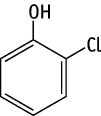

The single oral dose LD50 value of 2-chlorophenol was approximate 2000 mg/kg for both sexes.
2-Chlorophenol was studied for oral toxicity in rats in a 28-day repeat dose toxicity test at 0, 8, 40, 200 and 1000 mg/kg.
Tremors, decrease in locomotor activity, abnormal gait, and a prone or lateral position were observed in the 1000 mg/kg group, and salivation was observed in the 200 and 1000 mg/kg groups. Blood chemical examination revealed a decrease in inorganic phosphorus and an increase in triglyceride in the 1000 mg/kg group. In the liver, increases in absolute and relative weights, dark brownish color, and hypertrophys of hepatocyte were observed in the 1000 mg/kg group. The NOEL is considered to be 40 mg/kg/day for both sexes.
2-Chlorophenol was not mutagenic in Salmonella typhimurium TA100, TA1535, TA98, TA1537 and Escherichia coli WP2 uvrA, with or without exogenous metabolic activation.
2-Chlorophenol induced structural chromosomal aberrations in CHL/IU cells after 6 hr short-term treatment without and with an exogenous metabolic activation system. Polyploidy was not induced in any treatment group.
| Purity | : | 99.49 % |
| Test species/strains | : | Rat/Crj:CD(SD)IGS |
| Test method | : | OECD Test Guideline 401 |
| Route | : | Oral (gavage) |
| Doses | : | 0(vehicle), 500, 1000, 2000 mg/kg |
| Number of animals/group | : | Males, 5; females, 5 |
| Vehicle | : | Olive oil |
| GLP | : | Yes |
Test results:
| Purity | : | 99.49 % |
| Test species/strain : Rat/Crj | : | CD(SD)IGS |
| Test method | : | Guideline for 28-Day Repeated Dose Toxicity Test in Mammalian Species (Chemical Substances Control Law of Japan) |
| Route | : | Oral(gavage) |
| Dosage | : | 0(vehicle), 8, 40, 200, 1000 mg/kg/day |
| Number of animals/group | : | Males, 6; females, 6 |
| Vehicle | : | Olive oil |
| Administration period | : | Males and females, 28 days |
| Terminal kill | : | Males and females, on days 29 and 43 |
| GLP | : | Yes |
Test results:
| Purity | : | 99.49% |
| Test species/strains | : | Salmonella typhimurium TA100, TA1535, TA98, TA1537, Escherichia coli WP2 uvrA |
| Test method | : | Guidelines for Screening Mutagenicity Testing of Chemicals(Chemical Substances Control Law of Japan) and OECD Test Guideline 471 |
| Procedures | : | Pre-incubation method |
| Solvent | : | DMSO |
| Positive controls | : | -S9 mix; 2-(2-Furyl)-3-(5-nitro-2-furyl)acrylamide (TA100, TA98), Sodium azide (TA1535), 9-Aminoacridine (TA1537) and N-Ethyl-N'-nitro-N-nitrosoguanidine (WP2 uvrA) +S9 mix; 2-Aminoanthracene (all strains) |
| Doses | : | -S9 mix; 39.1, 78.1, 156, 313, 625, 1250 and 2500 μg/plate(TA100, TA1535) -S9 mix; 156, 313, 625, 1250, 2500 and 5000 μg/plate(WP2 uvrA, TA98 and TA1537) +S9 mix; 39.1, 78.1, 156, 313, 625, 1250 and 2500 μg/plate(TA100, TA1535) +S9 mix; 156, 313, 625, 1250, 2500 and 5000 μg/plate(WP2 uvrA, TA98 and TA1537) |
| S9 | : | Rat liver, induced with phenobarbital and 5,6-benzoflavone |
| Plates/test | : | 3 |
| Number of replicates | : | 2 |
| GLP | : | Yes |
Test results:
Genetic effects:
Salmonella typhimurium TA100, TA1535, TA98 and TA1537
| + | ? | - | |
| Without metabolic activation: | [ ] | [ ] | [*] |
| With metabolic activation: | [ ] | [ ] | [*] |
Escherichia coli WP2 uvrA
| + | ? | - | |
| Without metabolic activation: | [ ] | [ ] | [*] |
| With metabolic activation: | [ ] | [ ] | [*] |
| Purity | : | 99.49 % |
| Type of cell used | : | Chinese hamster CHL/IU cells |
| Test method | : | Guidelines for Screening Mutagenicity Testing of Chemicals(Chemical Substances Control Law of Japan) and OECD Test Guideline 473 |
| Solvent | : | Dimethylsulfoxide |
| Positive controls | : | -S9 mix; Mitomycin C +S9 mix; Benzo[a]pyrene |
| Doses | : | -S9 mix(6 hr short-term treatment); 0, 62.5, 125, 250, 500 μg/mL(main test) -S9 mix(6 hr short-term treatment); 0, 200, 300, 400, 500 μg/mL(confirmation test) +S9 mix(6 hr short-term treatment); 0, 62.5, 125, 250, 500 μg/mL |
| S9 | : | Rat liver, induced with phenobarbital and 5,6-benzoflavone |
| Plates/test | : | 2 |
| GLP | : | Yes |
Test results:
Genetic effects:
| clastogenicity | polyploidy | |||||
| + | ? | - | + | ? | - | |
| Without metabolic activation: | [*] | [ ] | [ ] | [ ] | [ ] | [*] |
| With metabolic activation: | [*] | [ ] | [ ] | [ ] | [ ] | [*] |
| 1) | The tests were performed by the Kashima Laboratory, Mitsubishi Chemical Safety Institute Ltd., 14 Sunayama, Hasaki-machi, Kashima-gun, Ibaraki, 314-0255, Japan. Tel +81-479-46-2871 Fax +81-479-46-2874 |